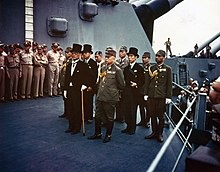Surrender (military)
| Part of a series on |
| War |
|---|

Surrender, in
Definition and etymology
Merriam-Webster defines "surrender" as "the action of yielding one's person or giving up the possession of something especially into the power of another", and traces the etymology to the Middle English surrendre, from French sur- or sus-, suz "under" + rendre "to give back";[1] this in turn is defined by the University of Michigan Middle English Dictionary as meaning "The giving up of an estate, a grant of land, or an interest in property to the person who holds the right to it", or, in law, "the relinquishing of letters patent to the king", or "the giving back or return of something".[2]
Signs and gestures of surrender

A
According to a leaflet given to British Empire troops before the
Process
When the parties agree to terms, the surrender may be conditional; that is, the surrendering party agrees to submit only after the victor makes certain promises. The leaders of the surrendering group negotiate privileges or compensation for the time, expense and loss of life saved by the victor through the stopping of resistance.[3]
Alternatively, in a
The
While not a formal military law, the
False surrender
False surrender is a type of perfidy in the context of war. It is a war crime under Protocol I of the Geneva Convention.[13] False surrenders are usually used to draw the enemy out of cover to attack them off guard, but they may be used in larger operations such as during a siege. Accounts of false surrender can be found relatively frequently throughout history.
See also
- Capitulation, an agreement in time of war for the surrender to a hostile armed force of a particular body of troops, a town or a territory.
- Debellatio occurs when a war ends because of the complete destruction of a belligerent state.
- No quarter occurs when a victor shows no clemency or mercy and refuses to spare the life of the vanquished when they surrender at discretion. Under the laws of war, "it is especially forbidden ... to declare that no quarter will be given".
- Unconditional surrender is a surrender without conditions, except for those provided by international law.
References
- ^ "Surrender". Merriam-Webster. Retrieved 7 October 2016.
- ^ "Surrendre". Middle English Dictionary. The University of Michigan. Retrieved 7 October 2016.
- ^ a b Francis Newton Souza (1982). The White Flag Revolution: A New Theory, a New Symbol, a New Force, a New Art. Mastermind Publications. p. 70.
- ISBN 978-0-19-754604-8– via Google Books.
- ^ A Naval Encyclopedia. Philadelphia: L. R. Hamersly & Co. 1881.
- ISBN 9781473851092– via Google Books.
- ^ ISBN 978-1-62356-603-6.
- ^ The Program for Humanitarian Policy and Conflict Research at Harvard University, "IHL PRIMER SERIES | Issue #1" Accessed at "Archived copy" (PDF). Archived from the original (PDF) on 2013-12-30. Retrieved 2013-12-29.
{{cite web}}: CS1 maint: archived copy as title (link) - ^ Greenspan, Morris (1969). The Soldier's Guide to the Laws of War. Washington, DC: Public Affairs Press. p. 10.
- ^ "Convention (III) relative to the Treatment of Prisoners of War. Geneva, 12 August 1949". International Committee of the Red Cross. Retrieved 7 October 2016.
- ^ "FM 19-40 Enemy pisoners of war and civilian internees" (PDF). survivalebooks.com. Department of the Army. Retrieved 7 October 2016.
- ^ "Code of Conduct for Members of the United States Armed Forces". Air University. US Air Force. Retrieved 7 October 2016.
- ^ "Protocol Additional to the Geneva Conventions of 12 August 1949, and relating to the Protection of Victims of International Armed Conflicts (Protocol I), 8 June 1977". International Committee of the Red Cross. Retrieved 7 October 2016.
